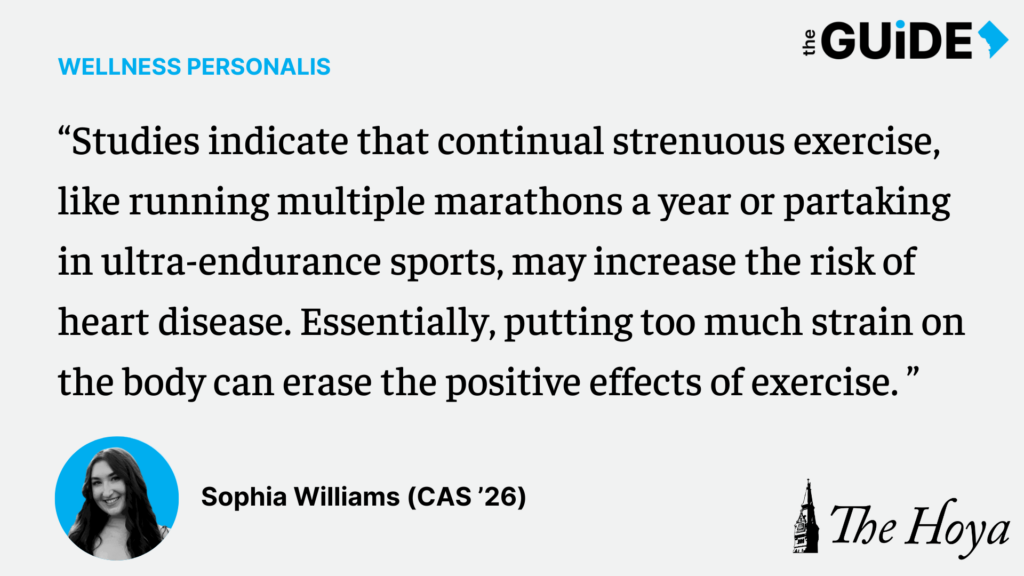Since my last column covered committing to a workout plan, I find it only fitting to now discuss the optimal length of a workout. After all, committing to a routine requires setting aside time amid the endless to-do list of a Georgetown student. Almost all of us have heard that working out offers us innumerable benefits, and working out a little bit is better than doing nothing. But what do these statements mean scientifically?
The exercise baseline for the average adult is 150 to 300 minutes (2.5 to 5 hours) of moderate aerobic exercise a week, according to the U.S. Department of Health and Human Services. Their activity guidelines qualified that 75 to 150 minutes of “vigorous-intensity” activity can also count toward this baseline.
This aerobic exercise could mean walking, running, bicycling, jumping rope and swimming, according to the guidelines. As Georgetown students, meeting this goal could include two one-hour long workouts and one 30 minute workout a week, or five 30-minute workouts a week. A 30-minute intense workout can result in increased muscle mass and better cardiovascular health.
What about weightlifting? Peloton recommends “two to three 30-45-minute sessions” per week. Yates-goers know that weightlifting can involve rest between sets, which can increase overall time at the gym. Healthline outlines what scientific reviews have to say regarding rest time:
- If your goal is muscular strength, your rest time should be 2-5 minutes.
- If your goal is hypertrophy, your rest time should be 60-90 seconds.
- If your goal is muscular endurance, your rest time should be 20-120 seconds.
If you want to make your Yates workout more efficient so you can maximize your time at Lau (because who wouldn’t), Healthline recommends performing supersets, or pairing exercises together to essentially eliminate rest time.
Keep in mind that during the Yates afternoon rush hours, performing supersets might only be possible if you find another person to work out with. The two of you can switch between two machines. Otherwise, you might find yourself under the weight of irritated stares if you reserve two precious machines to yourself.
So, now we know the recommended baseline for the length of a workout, but can a workout ever be too long? Does a certain point exist at which progress would decline? Studies indicate that continual strenuous exercise, like running multiple marathons a year or partaking in ultra-endurance sports, may increase the risk of heart disease. Essentially, putting too much strain on the body can erase the positive effects of exercise.
What do student athletes think about the concept of “too much” exercise? I asked members of the Georgetown swimming and diving team for their thoughts on the optimal length of a workout. For Georgetown swimmers, each workout is generally one and a half to two hours. They practice for two hours in the afternoon and an hour and a half in the mornings. During longer practices, the team does more warmups and stroke work.
Shorter workouts — like one-hour lift workouts — efficiently get the team into the main set. Varsity swimmers evidently surpass the exercise baseline, but they do so in a controlled manner. The key is that they have built up their endurance over time. So, if you want to challenge yourself — like the swimmers — you should use consistency to gradually build up activity and increase frequency.
Nevertheless, the length of your workout should ultimately depend on your goals, lifestyle and bodily cues. The goal factor means considering if you want to run a marathon (or swim on an elite college swim team) versus if you want a break from a long day of classes. The first goals imply more of a time commitment, increasing the duration of the workouts best suited to you. The lifestyle factor means considering how much time you have throughout the week to dedicate to exercise. Lastly, the bodily cues factor means remaining cognizant of your own limits and being careful to avoid overtraining and injury — as Georgetown swimmers shared. As long as we work toward the baseline of 150 to 300 minutes a week, we’ll receive the overall health and longevity benefits of exercise. But to answer the individual question of how long our workouts should be, we need to turn to three factors: goals, lifestyle and bodily cues.














